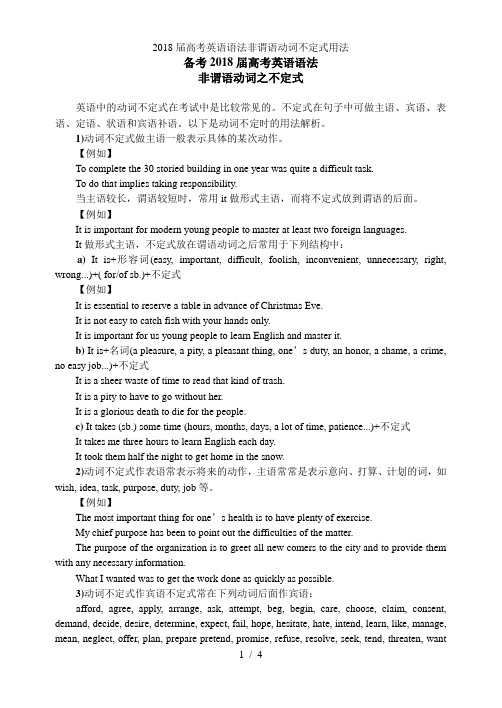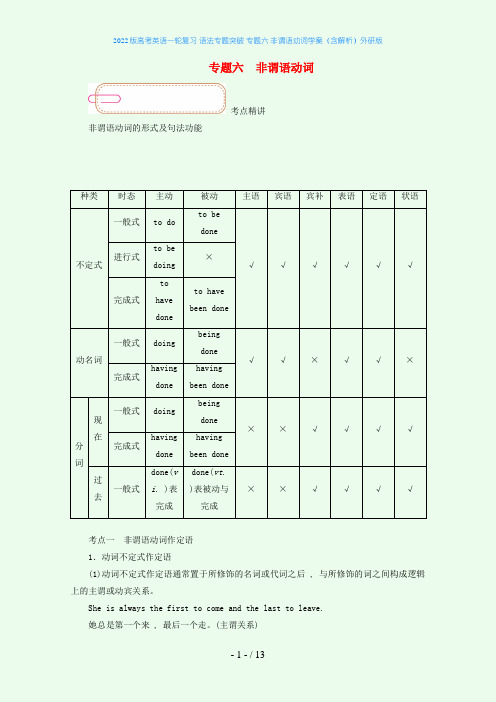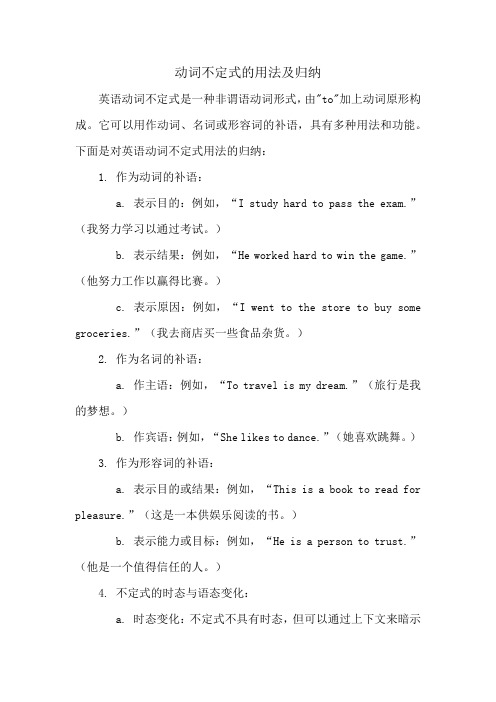高考英语精准考点 动词不定式的用法
高考英语:非谓语动词考点

外教一对一高考英语:非谓语动词考点一、分类:动词不定式、动词-ing形式、动词的过去分词总的特点:1.非谓语动词作状语时,其逻辑主语与主句主语保持一致。
2.Doing/To do (sth.)+单数V : 非谓语动词作主语,谓语用单数。
二、动词不定式1、特点:表将来2、形式:①基本型:to+动词原形(do)。
②被动式:to be done ③完成时:to have done ④进行时:to be doing3、句子功能:主语、宾语、表语、定语、状语、补语(宾补)Eg: ①To catch the early train, you`ll have to get up early.(目的状语)②I rushed there in a taxi only to find the library closed.(结果状语:意外结果)。
③This i s very good music to dance to.(定语)④It is necessary to learn English well.(主语,it 为形式主语)4、不定式的省略1)(为了避免重复)并列结构中第二个to:I want to get up early and read English.例外:前后表对比时,to不可省去:To be or not to be ,that is the question.It is better to lose one’s life than to lose one’s spirit.2) (为了避免重复)省去to后的不定式结构:—Would you like to go shopping?—Yes,I`d like to.例外:to后有have/be时,保留be或have—Did you go shopping yesterday? —No, but I ought to have.5、不定式主动形式表被动意义外教一对一1)主(sth)+ be + 主补/表语(表性质的adj. + to do)2) 主+Vt + 宾语 + 宾补(adj.+ to do)3) 主 + Vt+ 宾语+定语(to do): 不定式作定语与所修饰的名词(代词)构成逻辑动宾关系,又和该句主语构成逻辑上的主谓关系。
高考英语-动词不定式-知识点考点全梳理

高考英语-动词不定式-知识点考点全梳理动词不定式在句中的成分1,作主语:To read English aloud is very important 大声朗读英语是很重要的It's very important to read English aloud 大声朗读英语是很重要的。
2,作宾语:I want to play football 我想要踢足球。
I find it easy to study English 我发现学习英语是很容易的。
3,作表语:My plan is to study English well 我的计划就是把英语学好。
4,作定语:I must find a man to talk 我必须找到一个人去聊天I have nothing to do 我没有可以做的事情。
5,作状语;We did a lot of work just to improve our abilities我们做这么多的工作就是为了提高我们的能力。
He got up early that day ,only to be told that it's Saturday5,作补语:He asked me to do homework 他叫我去写作业He was asked to finish the work 他被叫去完成这个工作。
二,疑问词+不定式的句子成分1,做主语:How to study English well is so important 如何把英语学好是很重要的。
2,做表语:My question is how to find it 我的问题就是如何找到它。
3,做宾语:If you want to know what to eat,you must have a menu 如果你想要知道吃什么?你必须有一个菜单。
He is worrying about where to go 他正在担心去哪里不定式的几种时态形式You seems to play football well你好像踢足球还不错(状态)You seems to be playing football very happily on the playground你好像正在操场上打球很开心哦(动作)You seems to have played football for two hours你好像已经踢足球已经两个小时了。
高考英语语法非谓语动词不定式用法

备考2018届高考英语语法非谓语动词之不定式英语中的动词不定式在考试中是比较常见的。
不定式在句子中可做主语、宾语、表语、定语、状语和宾语补语。
以下是动词不定时的用法解析。
1)动词不定式做主语一般表示具体的某次动作。
【例如】To complete the 30 storied building in one year was quite a difficult task.To do that implies taking responsibility.当主语较长,谓语较短时,常用it做形式主语,而将不定式放到谓语的后面。
【例如】It is important for modern young people to master at least two foreign languages.It做形式主语,不定式放在谓语动词之后常用于下列结构中:a)It is+形容词(easy, important, difficult, foolish, inconvenient, unnecessary, right, wrong...)+( for/of sb.)+不定式【例如】It is essential to reserve a table in advance of Christmas Eve.It is not easy to catch fish with your hands only.It is important for us young people to learn English and master it.b) It is+名词(a pleasure, a pity, a pleasant thing, one’s duty, an honor, a shame, a crime, no easy job...)+不定式It is a sheer waste of time to read that kind of trash.It is a pity to have to go without her.It is a glorious death to die for the people.c) It takes (sb.) some time (hours, months, days, a lot of time, patience...)+不定式It takes me three hours to learn English each day.It took them half the night to get home in the snow.2)动词不定式作表语常表示将来的动作,主语常常是表示意向、打算、计划的词,如wish, idea, task, purpose, duty, job等。
2022版高考英语一轮复习 语法专题突破 专题六 非谓语动词学案(含解析)外研版

专题六非谓语动词考点精讲非谓语动词的形式及句法功能种类时态主动被动主语宾语宾补表语定语状语不定式一般式to doto bedone√√√√√√进行式to bedoing×完成式tohavedoneto havebeen done动名词一般式doingbeingdone√√×√√×完成式havingdonehavingbeen done分词现在一般式doingbeingdone××√√√√完成式havingdonehavingbeen done过去一般式done(vi. )表完成done(vt.)表被动与完成××√√√√考点一非谓语动词作定语1.动词不定式作定语(1)动词不定式作定语通常置于所修饰的名词或代词之后 , 与所修饰的词之间构成逻辑上的主谓或动宾关系。
She is always the first to come and the last to leave.她总是第一个来 , 最后一个走。
(主谓关系)Have you got a letter to write?你有信要写吗?(动宾关系)特别提示 : 动词不定式既可用主动式也可用被动式 , 但其含义有所不同。
试比拟 : Do you have anything to send? (动作的执行者是〞你〞)你还邮寄什么东西吗?Do you have anything to be sent ?(动作的执行者是〞我〞或〞别人〞)你还有什么东西要(我或别人)去寄吗?(2)当名词或代词被序数词、形容词最高级、the last、the only等修饰 , 且不定式与其逻辑主语为主谓关系时 , 常用动词不定式作定语。
He is the best man to do the job.他是做这项工作的最正确人选。
(3)当被修饰词是表示抽象意义的名词时 , 常用不定式作后置定语 , 且不定式常用主动形式。
动词不定式的用法总结

动词不定式的用法总结
1.作为句子的主语:
Ex: To study English is important for success.
2.作为句子的宾语:
Ex: I want to learn how to play the guitar.
3.作为动词的宾语补语:
Ex: She found it difficult to understand the instructions.
4.与一些动词连用,构成特定的动词短语:
Ex: I need to go to the store.
He wants to buy a car.
5.作为目的状语,表示动作的目的或意图:
Ex: He went to the library to study.
6.作为结果状语,表示结果或后果:
Ex: She studied hard to pass the exam.
7.作为方式状语,表示动作的方式或方法:
Ex: He walked slowly to avoid falling.
8.与形容词连用,表示主语的特征或状态:
Ex: She is happy to see her friends.
9.与副词连用,表示副词的程度或程度的变化:
Ex: He tried to be more careful.。
高考英语语法词汇专项突破:动词不定式省略标志词to的情况

高考英语语法词汇专项突破:动词不定式省略标志词to的状况大家知道动词不定式是由动词原形与标志词to构成,就是常见的to do sth.形式,但是却有不少状况下作为标志词的小品词to不见了。
这是怎么回事呢?现在就跟同学们聊聊不定式省掉to的那些事儿。
一、作宾语补足语的不定式省掉to的状况(一)当let, make, have等使役动词后跟不定式作宾语补足语时,不定式必需省略to。
但是假如使役动词用在被动语态中则to不行以省掉,其实let与have极少用于被动语态。
像get, force, oblige等使役动词跟不定式作宾补时无论用于主动还是被动to都不行以省掉。
如:1. There is no need to tell me your answer now. Give it some thought and then let me know.(XXXX·安徽卷30)2. My parents have always made me feel good about myself, even when I was twelve.(XXXX江苏35)3. She had him dig away the snow.她让他把雪挖走。
4. The law obliged parents to send their children to school. 法律要求父母送子女上学。
【考例】(XXXX·浙江卷短文改错)The position of the classroom with its view made me felt like I was dreaming.【答案与解析】felt改为feel。
考查使役动词make sb. do sth的用法,make跟不定式作宾语补足语在主动语态中不带to,me与宾语feel之间是规律上主谓关系,不能用表示被动意义的过去分词felt。
(二)当表示感觉的动词feel, hear, notice, observe, see, watch, look at, listen to等跟不定式作作宾语补足语时,在主动语态中不定式省略to,但是在被动语态中的to须带上。
高中动词不定式的用法总结

高中动词不定式的用法总结
1. 作主语(主语通常为it):
- It is important to study every day.
- To travel is my dream.
2.作宾语:
- I want to sleep.
- She likes to dance.
3.作补语:
- My plan is to take a vacation.
4. 与一些动词连用,如agree, decide, hope, plan, want等:
- I decided to go to the party.
5.作状语表示目的、原因、结果等:
- He went to the bookstore to buy a new book.
- I ran fast to catch the bus.
6.作状语表示条件或让步:
- He studied hard to pass the exam.
- She tried her best to finish the project.
7.与形容词连用表示结果:
- She was happy to receive the gift.
- He is excited to start his new job.
8.作宾补:
- They made me play the piano.
- I saw him leave the room.
9.作定语表示目的或所需工具:
- We need a pen to write.
- She bought a bookshelf to organize her books.。
动词不定式的用法及归纳

动词不定式的用法及归纳英语动词不定式是一种非谓语动词形式,由"to"加上动词原形构成。
它可以用作动词、名词或形容词的补语,具有多种用法和功能。
下面是对英语动词不定式用法的归纳:1. 作为动词的补语:a. 表示目的:例如,“I study hard to pass the exam.”(我努力学习以通过考试。
)b. 表示结果:例如,“He worked hard to win the game.”(他努力工作以赢得比赛。
)c. 表示原因:例如,“I went to the store to buy some groceries.”(我去商店买一些食品杂货。
)2. 作为名词的补语:a. 作主语:例如,“To travel is my dream.”(旅行是我的梦想。
)b. 作宾语:例如,“She likes to dance.”(她喜欢跳舞。
)3. 作为形容词的补语:a. 表示目的或结果:例如,“This is a book to read for pleasure.”(这是一本供娱乐阅读的书。
)b. 表示能力或目标:例如,“He is a person to trust.”(他是一个值得信任的人。
)4. 不定式的时态与语态变化:a. 时态变化:不定式不具有时态,但可以通过上下文来暗示时间关系。
b. 语态变化:不定式可以通过添加"be"动词的相应形式来表示被动语态。
例如,“He wants to be invited to the party.”(他希望被邀请参加派对。
)总之,不定式在句子中扮演着多种角色,并且具有多种用法和功能,具体使用取决于上下文和意图。
- 1、下载文档前请自行甄别文档内容的完整性,平台不提供额外的编辑、内容补充、找答案等附加服务。
- 2、"仅部分预览"的文档,不可在线预览部分如存在完整性等问题,可反馈申请退款(可完整预览的文档不适用该条件!)。
- 3、如文档侵犯您的权益,请联系客服反馈,我们会尽快为您处理(人工客服工作时间:9:00-18:30)。
动词不定式的用法1 不定式作宾语动词+ 不定式afford, aim, appear, agree, arrange, ask, be, decide, bother, care, choose, come, dare, demand, desire, determine, expect, elect, endeavor, hope, fail, happen, help, hesitate, learn, long, mean, manage, offer, ought, plan, prepare, p retend, promise, refuse, seem, tend, wait, wish, undertakeThe driver failed to see the other car in time. 司机没能及时看见另一辆车。
I happen to know the answer to your question. 我碰巧知道你那道问题的答案。
2) 动词+不定式;动词+宾语+不定式ask, beg, choose, expect, hate, help intend like, love, need prefer, prepare, promise, want, wishI like to keep everyt hing tidy. 我喜欢每件东西都保持整洁。
I like you to keep everything tidy. 我喜欢你使每件东西都保持整洁。
I want to speak to Tom. 我想和汤姆谈话。
I want you to speak to Tom. 我想让你和汤姆谈话。
3) 动词+疑问词+ todecide, know, consider forg et, learn, remember, show, understand, see, wonder, hear, find out, explain, tellPlease show us how to d o that. 请演示给我们如何去做。
There are so many kinds of tape-recorders on sale that I can't make up my mind which to buy.有这么多的录音机,我都拿不定主意买哪一种。
注意疑问词带不定式在句中作成分时,谓语动词用单数。
如:The question is how to put it into practice. 问题是怎样把它付诸实施。
2. 不定式作补语1) 动词+宾语+不定式(to do)advise, allow, appoint, believe, cause, challenge, command, compel, consider, declare, drive, enable, encourage, find, forbid, force, guess, hire, imagine, impel, induce, inform, instruct, invite, judge, know, like, order, permit, persuade, remind, report, request, require, select, send, state, suppose, tell, think, train, trust, understand, urge, warna. Father will not allow us to play on the street. 父亲不让我们在街上玩耍。
b. We believe him to be guilty. 我们相信他是有罪的。
Find 的特殊用法Find 后可用分词做宾补,或先加形式宾语,再加形容词,最后加带to 的动词不定式。
find后也可带一个从句。
此类动词还有get,have。
I f ound him lying on the ground.I found it important to learn.I found that to learn English is important.典型例题The next morning she found the man ___ in bed,dead.A. lyingB. lieC. layD. laying答案:A. find的宾语后面,用分词或分词短语,起宾语补足语作用。
现在分词表达主动,也表达正在进行,过去分词表达被动。
2) to + be 的不定式结构,作补语的动词。
acknowledge, believe, consider, think, declare(声称), discover, fancy(设想), feel, find, guess, judge, imagine, know, prove, see(理解), show, suppose, take(以为), understandWe consider Tom to be one of the best students in our class. 我们认为汤姆是班上最好的学生之一。
典型例题Charles Babbage is generally considered ___ the first computer.A. to inventB. inventingC. to have inventedD. having invented答案:A. 由consider to do sth. 排除B、D。
. 此句只说明发明这一个事实,不定式后用原形即可。
而C为现在完成时,发明为点动词一般不用完成时,且此处也不强调对现在的影响,因此不选C。
3) to be +形容词seen, appear, be said, be supposed, be believed, be thought, be known, be reported, hope, wish, desire, want, plan, expect, meanThe book is believed to be uninteresting. 人们认为这本书没什么意思。
4) there be+不定式believe, expect, intend, like, love, mean, prefer, want, wish, understandWe didn't expect there to be so many people there. 我们没料到会有那么多人在哪里。
注意有些动词需用as 短语做补语,如regard, think believe, take, consider.We regard Tom as our best teacher. 我们认为汤姆是我们最好的老师。
Mary took him as her father . 玛丽把他当作自己的父亲。
1) It's easy (for me) to do that. 我做这事太容易了。
easy, difficult, hard, important, possible, impossible, comfortable, necessary, better;the first, the next, the last, the best, too much, too little, not enoughIt's so nice to hear your voice. 听到你的声音真高兴。
It's necessary for you t o lock the car when you do not use it. 当你不用车的时候,锁车是有必要的。
2) It's very kind of you to help us. 他帮助我们,他真好。
kind, nice, stupid, rude, clever, foolish, thoughtful, thoughtless, brave, considerate(考虑周到的), silly, selfish(自私的)It was silly of us to believe him. 我们真愚蠢,竟然相信了他。
It seemed selfish of him not to give them anything. 他不给他们任何东西,这显得太自私了。
注意1) 其他系动词如,look,appear等也可用于此句型2) 不定式作为句子成分时,动词用单数形式。
3) 当不定式作主语的句子中又有一个不定式作表语时,不能用It is… to…的句型(对)To see is to bel ieve. 百闻不如一见。
(错)It is to believe to see.It's for sb.和 It's of sb.1) for sb. 常用于表示事物的特征特点,表示客观形式的形容词,如easy, hard, difficult, interesting, impossible等:It's very hard for him to study two languages. 对他来说学两门外语是很难的。
2) of sb的句型一般用表示人物的性格,品德,表示主观感情或态度的形容词,如good, kind, nice, clever, foolish, right。
It's very nice of you to help me. 你来帮助我,你真是太好了。
for 与of 的辨别方法用介词后面的代词作主语,用介词前边的形容词作表语,造个句子。
如果道理上通顺用of,不通则用for。
如:You are nice. (通顺,所以应用of)。
He is hard. (人是困难的,不通,因此应用for。
)4. 不定式作表语不定式可放在be动词后面,形成表语。
例如:My work is to clean the room every day.His dre am is to be a doctor.5. 不定式作定语不定式做定语通常要放在被修饰的词后。
例如:I have a lot of work to do.So he made some candles to give light.。
